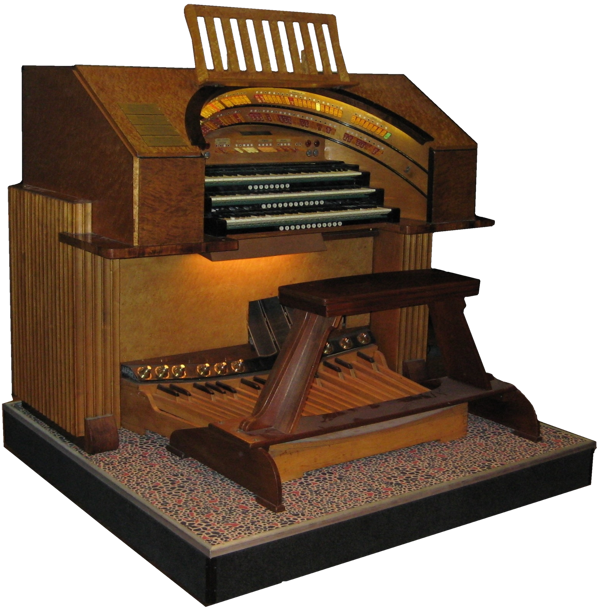In the past year I shed some light on the theatre organs made by the Standaart company. Standaart was the largest manufacturer of theatre organs on the Dutch market and probably built fifty to sixty instruments in the Netherlands alone. Today just a handful of these are left. A fine example of an original Standaart organ is installed in the Fortis Theater aan de Schie in Schiedam, and in Boskoop the NOF/VARA organ will soon be installed.
Of course we musn’t forget the large Standaart/Compton concert organ from the former AVRO studio which is currently in storage, waiting for a new location to be found. This organ was Standaart’s largest creation in the theatre organ genre: 4 manuals, 18 ranks and originally the fourth manual was coupled to another 7 church organ ranks. On account of Standaart’s bankruptcy during the installation the organ was finished in 1936 by Compton. Hence the Compton label on the console and not Standaart, although a large part of the instrument is by Standaart.
An update on the AVRO organ: during the war the Saxophone was replaced with a Koppelfluit (at the request of Pierre Palla) and a so-called Jazz Trompet was added (on the advice of Cor Steyn). This was all done by Strunk, and this brings me nicely to Johann Theodor Strunk, born 14th June 1899 in Poppelsdorf in Germany. As a young man he was employed by Klais but after several years he moved to the Netherlands. Here he entered the employ of the Standaart firm, where his knowledge of electro-pneumatic systems served him well.
At Standaart, Theo Strunk soon developed into an excellent voicer. Towards the end of the 1920’s though, he decided to leave the firm and, with a partner, started his own company in Rotterdam: the firm of Blaisse-Strunk. He took various employees with him from Standaart and probably several clients as well. From then on Standaart and Strunk were at war. The first VARA organ that had been built by Standaart in 1929, was re-voiced by Strunk the following year. Standaart was of course very unhappy about this and stated in an advertisement that the VARA had had the good sense to keep the general maintenance of the organ with Standaart. That gives a fairly good picture of the rivalry between the two companies......
Strunk’s first little theatre organ (4 ranks) was built for the Luxor theatre in Vlaardingen in 1930. In 1933 a young organist was engaged at this theatre who went by the stage name of Dave Lincy. This was none other than the future conductor of the Metropoleorkest, Dolf van der Linden!
In 1931 Strunk received an important commission, namely for a new organ for the prestigious ASTA theatre in The Hague. This had a large auditiorium that seated 1200 and Strunk wanted to surpass everything that Standaart had previously done. It was to be a 4-manuarl organ with no less than 21 ranks. Several ranks from the original Oskalyd organ were reused by Strunk in the new instrument. These Oskalyd ranks are probably still to be found in the ASTA organ, which later was moved to Steenwijk.
Strunk did have some unusual ideas for what would be a suitable specification for the organ. He had three organ chambers, of which the pipework in the main chamber was playable only on the first two manuals (Accompaniment and Great) and the two solo chambers were playable from the third and fourth manuals respectively. By doing this, one is not following the principles of total unification (generally the norm with theatre organs) and thus restricting the possibiliy of having every rank available on every manual.
At the instigation of Strunk, Bernard Drukker was appointed as the first organist on the new ASTA organ. Drukker already had plenty of experience playing theatre organ from his time at the Cinema Royal in Amsterdam, and Strunk was keen to have a good organist on ‘his’ instrument.
In 1935 Strunk was commissioned to build an organ for the new City theatre in Amsterdam that had an auditorium that seated 1600. Strunk most likely unearthed the designs for the ASTA organ again, as there is a marked similarity between the instruments. The console is an exact copy of the ASTA and here too there is the use of three chambers.
Unfortunately this was a commission for a very low budget and that is reflected in the specification. Strunk still planned to make 22 ranks, with 10 in the top chamber (manual 1); 8 in the lower chamber (manuals 2 and 3) and 4 ranks in the Echo chamber (4th manual), but only five of these were reeds. Generally the proportion of flue ranks to reeds in an organ of more than 10 ranks is about fifty-fifty. However, reed pipes are much more expensive to make than flues and so that was all that could be afforded.



